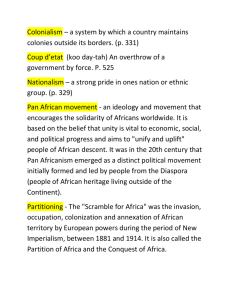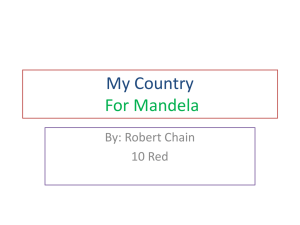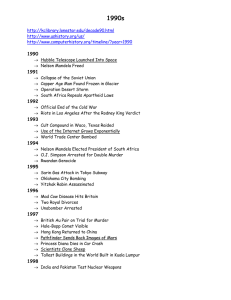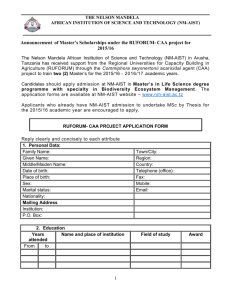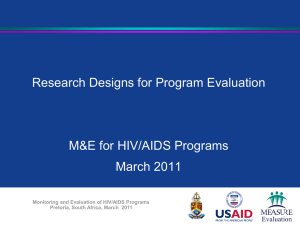south africa - bethwallace
advertisement
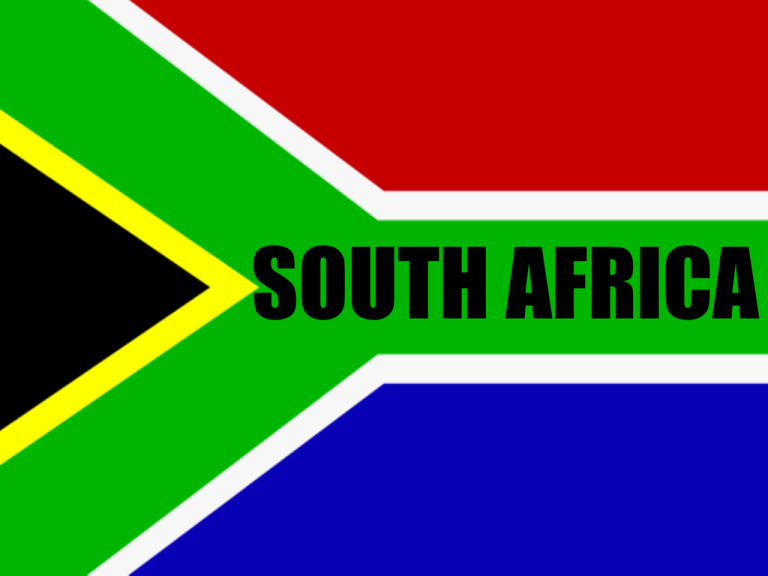
SOUTH AFRICA Fast Facts • capital: Pretoria (Cape Town is the legislative centre) • population: 48,810,427 (est. July 2012) • language: IsiZulu 23.8%; IsiXhosa 17.6%; Afrikaans 13.3%; Sepedi 9.4%; English 8.2%; other 27.7% • ethnic groups: black African 79%; white 9.6%; coloured 8.9%; Indian/Asian 2.5% • religion: Zion Christian 11.1%; Pentecostal 8.2%; Catholic 7.1%; other Christian 46.5%; Islam 1.5% • land area: 1,219,912 km2 water: 2,798 km2 • land elevation: 0 metres – 3,408 metres • government: republic • currency: South African rand (1 CAD = 8.04 ZAR) • The country of Lesotho is in the middle of South Africa • (estimates for this country explicitly take into account the effects of excess mortality due to AIDS; this can result in lower life expectancy, higher infant mortality, higher death rates, lower population growth rates, and changes in the distribution of population by age and sex than would otherwise be expected.) Map of South Africa Johannesburg Durban Pretoria Port Elizabeth Cape Town Kimberley History of South Africa • Civilizations 1000s of years ago dominated by agricultural practices and eventually trading. • First European settlement in South Africa = Cape Town (1652) by the Dutch East India Company (created to supply passing ships, but grew quickly through Dutch farming and the addition of imported slaves to the colony). • 1700s = colonists and chiefdoms fought in wars for land and control. • 1806: Britain occupied the Cape ( international trade). Throughout the 1800s, European influence spread into the land of the Zulus. • 1838: slavery abolished, development of sugar plantations in the coastal lowlands, large numbers of Indian labourers ‘imported’. • 1860s: Diamonds discovered near what is now Kimberley (brought 1000s to area and caused civil war over control of resource). • 1886: Gold discovered (turning point in history for South Africa, as the British and the Boers (Dutch settlers) went to war again over control of a resource). 1000s died in British farm burnings and concentration camps. • 1910: Union of South Africa (essentially white in terms of political rights and powers). 1912: black opposition formed- protest exclusion of blacks from power. • Job reservation favoured whites and disenfranchisement of coloured voters fuelled Afrikaner nationalism. • After WWII (1948), apartheid – authoritarian racial segregationist government – solidifying white power and developing black opposition politics. • 1950s: concerns with racial purity, prohibited interracial sex, created racial categorization of population (pass), and enforced residential segregation. • 1960s: Defiance Campaign resisted - nonviolent means for human rights and non-racialism. By the end of the decade, black political organizations turned to armed conflict. Nelson Mandela and others were convicted of ‘sabotage’ and were sentenced to life imprisonment. • 1970s: resurgence of resistance politics; anti-apartheid revolt; resistance to white-minority rule. • 1980s: shaken by scale of protest and opposition, series of reforms took place; no longer had to carry a pass; support from the international community and the UN. • 1990s: unbanned liberation movements; political prisoners released (Nelson Mandela); first democratic election (1994) • Mandela = South Africa’s first democratically elected president; welcomed back into the international community. 'I have cherished the ideal of a democratic and free society in which all persons live together in harmony and with equal opportunities... it is an ideal for which I am prepared to die.' Nelson Mandela 1963 trial Culture in South Africa • South Africa is known as the Rainbow Country because of its diversity of people, cultures, and natural scenery. • It is this reputation, the peaceful transition to democracy, a president that is targeting issues, and a bright future that attracts tourists to the area. • There is real defined South African culture due to the different cultural backgrounds of the people that shaped Africa’s history. • The Come Home Campaign was launched in 2003 to encourage and assist South African emigrants to return to and settle in the country of their birth. (promotes solidarity and brings back educated and experienced adults to help society) SOUTH AFRICA HIV/AIDS in South Africa • Major problem in South Africa; efforts by local government & nongovernmental agencies to combat AIDS (awareness, behaviour change, medical/economic/ social support) • Estimated 6 million South Africans expected to die from AIDS-related diseases in the next 10 years (currently 5.3 million HIV +) • The high level of HIV/AIDS in South Africa can cause problems for the tourism industry by travellers having false fears and a negative view about transmission of the disease • “As the level of HIV/AIDS infection in South Africa is very high, you should be cautious about activities involving the transmission of bodily fluids.” (Travel Advisory – Gov’t of Canada) • Transmission -- unprotected sexual intercourse, shared, unsterilized needles, pregnancy, bodily fluids • HIV not transmitted through shaking hands, kissing, coughing/sneezing, toilet seats, giving blood, pools, sharing food/water fountains, insects Tourism in South Africa • With its unique background, culture, and natural landscape, South Africa’s tourism industry is growing rapidly. • South Africa has a well developed infrastructure, high standards of water treatment, and modern medical facilities that would help tourists feel safe and secure. • Popular attractions in South Africa: - Kruger Park (game park) - Table Mountain - Garden Route (coastal villages and resorts) - Robben Island (Mandela jail cell) - beaches - shopping Wildlife in South Africa
